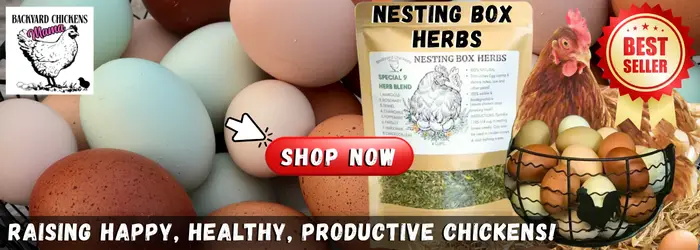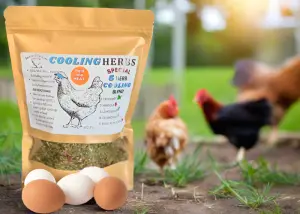
It sure would be nice if our chickens could talk to us to let us know how they are doing. Did you know that you can tell a lot about a chickens health and well-being just by observing their crop? If you own chickens, you should know about these 5 important things your chicken’s crop is trying to tell you.
What is a Chicken Crop?

A chickens crop is a muscular pouch that food is temporarily stored in when eaten. It is here that the food is first mixed with digestive enzymes in the saliva along with grit(tiny stones). From here, it is passed to the chickens proventriculus (stomach).
“Because chickens are prey animals and are at risk of becoming attacked by predators, they swallow their food whole. This shortens the amount of time out in the field foraging for food. Instead, it is stored in the crop until the chicken can safely break it down as it is pushed along through its digestive system.“
Chicken Sour Crop – How to Best Cure
A chickens crop is located in the chest area, just slightly on the right side.
Occasionally, something goes wrong when the food is being stored in the crop. It is very important to be able to identify what is wrong and begin treatment right away.
The sooner crop problems are addressed, the better the odds of a positive outcome.
1. Empty Chicken Crop
Next time you let your chickens out in the morning observe their chest region. It should be flat, without any prominent bump or bulge and it should be difficult to palpate their crop because it is deflated.
Normal Emptying of a Chicken Crop
NORMAL: First thing in the morning it is normal for all chickens to have an empty crop.
NORMAL: Food can remain in the crop for up to 12 hours and as few as 2 hours. Depending upon when and how often a chicken eats, its crop can empty several times throughout the day.
NORMAL: All chickens should go to roost at night with a full crop and come out of the coop each morning with an empty crop.
Signs of an Abnormal Chicken Crop
ABNORMAL: Crop is hanging down, but feels empty.
ABNORMAL: Full crop in the morning. A chicken that has a full crop in the morning is a signal to you that something is not right.
2. Full Chicken Crop
Observe your chickens after you feed them in the morning. They should all have full crops and this should be evident by a bulge in their chest region, just slightly to the right over the right breast.
What a Normal, Full Chicken Crop Looks Like
NORMAL: You should notice a bulge in your chickens chest region when it has a full crop.
NORMAL: When you palpate a full crop, it should be firm, but you should be able to move it around.
NORMAL: Chickens should have a full crop before going to roost at night.
Signs of an Abnormally Full Chicken Crop
ABNORMAL: Crop is full in the morning.
ABNORMAL: Crop is very hard.
ABNORMAL: Crop is full, but is hanging down and swings when my chicken walks.
ABNORMAL: Sour smell coming from chickens beak.
ABNORMAL: Crop is squishy, like a water balloon.
3. Squishy, Sour Smelling Crop
Why does my chicken have a squishy crop? If your chicken crop feels like a water balloon or if it has a squishy crop, it is most likely suffering from sour crop.
Sour crop is a fungal infection caused by food getting stuck or staying in the crop too long. When this happens, the fungus Candidia albicans gets out of hand, causing inflammation in the crop.
How to Determine if your Chicken Has a Sour Crop
FEEL: Feel your chickens crop. A sour crop will feel squishy, like a water ballon.
SMELL: Lean down and smell your chickens breath. If you smell a sour type smell, like yeast or sauerkraut, it’s definitely sour crop.
LISTEN: Listen close to your chickens crop. Very gently rub the crop area. Do you hear any gurgling noise? If you do, this is because the food inside the crop is fermenting and causing a bacterial yeast infection. It is actually bubbling inside the crop.
OBSERVE: When you pick up a chicken that has a sour crop, it isn’t uncommon for some sour smelling fluid to come out of its mouth. Be gentle when picking up a chicken that you suspect has a sour crop because it can be painful, or at least uncomfortable for them.
For detailed information on how to treat sour crop in chickens, with Step by Step instructions, read my article below.
4. Hanging Crop
It is not normal if your chicken has a hanging crop. This is called a “pendulous crop” and in mild cases can be treated. It is called pendulous crop because when it walks, the crop will sway back and forth like a pendulum.
What is a Pendulous Crop?
In a normally functioning crop, the crop muscle will expand to hold the food and then go back to its normal size and shape after the food leaves the crop. In a pendulous crop, the muscle doesn’t go back to its resting size and the crop becomes overly distended.
The distended crop becomes filled with excess ingested food, fluid and gasses that cannot be passed into the proventriculus.
Treatment for Pendulous Crop
If it is caught soon enough, you can try using a “crop bra” to help support the crop. This aids in allowing the contents of the crop to dump into the proventriculus.
If left untreated, chickens suffering from this will often become malnourished and die.
5. Hard Crop
When a chickens crop is full, it should be firm, but not hard. You should be able to gently manipulate it with your fingers. If it is hard and not pliable, this is called an impacted crop. This can happen when a chicken eats too much fibrous or long foods as well as foreign objects.
A hard crop can occur if a chicken has:
- eaten too much tall grass.
- too much fibrous plant matter
- twine from hay bails
- string
- plastic or any other type of foreign object
- too much grit
- eats too much chicken feed after being without for some time(engorges)
Impacted Crop in Chickens
An impacted crop in a chicken will frequently stop food from exiting the crop and from moving on to the proventriculus or stomach. It is important to know the signs of an impacted crop so you can intervene, if necessary.
“If the birds will have access to pasture, keep the grazing areas cut short. Keep the area clear of non-feed material that could be consumed. Provide a source of grit.”
Crop Disorders of Chickens I: Crop Impaction
Signs of an Impacted Crop in a Chicken
- Hard crop
- Crop full in the morning
- Crop is not emptying
- Tender crop
- Lack of appetite
- Listlessness
- Weight loss
- Chicken may be withdrawn
- Decreased feces
How to Treat Impacted Crop
If your chicken isn’t eating, drinking, pooping and its crop remains hard, you will need to intervene. Treating an impacted chicken crop involves isolating, monitoring, manually emptying the crop and feeding a special diet until it empties into the proventriculus on its own.
How to Empty a Chicken Crop
- Give your chicken warm water or 1/2 TBS of vegetable oil to help loosen the blockage. If it doesn’t drink on its own, you can use a syringe to offer it through the side of its beak. Wait several minutes.
- While securely holding your chicken facing away from you, gently tip your chicken forward.
- Massage its crop to help break up the fibrous material.
- Take frequent breaks by bringing your chicken upright. This allows it to breathe easier.
- Repeat several times until it begins to regurgitate.
- The smell will be absolutely foul.
- Offer your chicken some plain, unsweetened yogurt and water with apple cider vinegar. This will help to get its crop bacteria flora back to normal.
- Return it to isolation where you can continue to monitor its crop, eating, drinking and pooping.
- Repeat until the crop empties into the proventriculus (first part of a chickens stomach) on its own.
- If this doesn’t help, you should contact your vet.
CONCLUSION: 5 Important Things Your Chicken’s Crop is Trying to Tell You
If you own chickens, you should know what a normal and abnormal chicken crop looks like. It is normal for a chicken crop to be full in the evening, but by morning it should be completely empty.
Observe your chickens before you feed them in the morning. A normally functioning chicken crop will be empty first thing in the morning. If it isn’t, this should be a signal to you that something is wrong.
| CROP ISSUE | SIGNS |
|---|---|
| SOUR CROP | 1. SQUISHY CROP (LIKE WATER BALLOON) 2. SOUR SMELL COMING FROM BEAK 3. GURGLING NOISE IN CROP |
| PENDULOUS CROP | 1. CROP DISTENDED (HANGS DOWN) 2. CANNOT EMPTY COMPLETELY |
| IMPACTED CROP | 1. HARD CROP 2. CROP NOT EMPTYING 3. POOPING LESS 4. WITHDRAWN 5. WEIGHT LOSS 6. DECREASED APPETITE |







